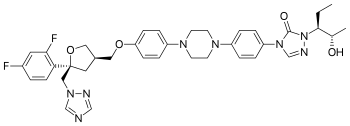Posaconazole
 | |
 | |
| Clinical data | |
|---|---|
| Trade names | Noxafil, Posanol |
| AHFS/Drugs.com | Monograph |
| MedlinePlus | a607036 |
| License data |
|
| Pregnancy category | |
| Routes of administration | By mouth (oral suspension, delayed-release tablets), IV |
| ATC code | J02AC04 (WHO) |
| Legal status | |
| Legal status |
|
| Pharmacokinetic data | |
| Bioavailability | High |
| Protein binding | 98 to 99% |
| Metabolism | Liver (glucuronidation) |
| Biological half-life | 16 to 31 hours |
| Excretion | Fecal (71–77%) and renal (13–14%) |
| Identifiers | |
| |
| Synonyms | 4-{4-[4-(4-{[(5R)-5-(2,4-difluorophenyl)-5-(1H-1,2,4-triazol-1-ylmethyl)oxolan-3-yl]methoxy}phenyl)piperazin-1-yl]phenyl}-1-[(2S,3S)-2-hydroxypentan-3-yl]-4,5-dihydro-1H-1,2,4-triazol-5-one |
| CAS Number |
171228-49-2 |
| PubChem (CID) | 147912 |
| DrugBank |
DB01263 |
| ChemSpider |
130409 |
| UNII |
6TK1G07BHZ |
| KEGG |
D02555 |
| ChEBI |
CHEBI:64355 |
| ChEMBL |
CHEMBL1397 |
| ECHA InfoCard | 100.208.201 |
| Chemical and physical data | |
| Formula | C37H42F2N8O4 |
| Molar mass | 700.778 g/mol |
| 3D model (Jmol) | Interactive image |
| |
| |
| | |
Posaconazole is a triazole antifungal drug.[1][2] It marketed in the United States, the European Union, and in other countries by Schering-Plough under the trade name Noxafil. In Canada, posaconazole is marketed by Schering-Plough under the trade name Posanol.
Medical uses
It is FDA-approved for the prophylaxis of invasive Aspergillus and Candida infections in patients who are at high risk of developing these infections due to being severely immunocompromised, such as HSCT recipients with GVHD or those with hematologic malignancies with prolonged neutropenia from chemotherapy. It is also used for the treatment of oropharyngeal candidiasis (OPC), including OPC refractory to itraconazole and/or fluconazole therapy.[3]
It is also used to treat invasive infections by Candida, Mucor, and Aspergillus species in severely immunocompromised patients.[4][5]
Clinical evidence for its utility in treatment of invasive disease caused by Fusarium species (fusariosis) is limited.[6]
Pharmacology
Mode of action
Posaconazole works by disrupting the close packing of acyl chains of phospholipids, impairing the functions of certain membrane-bound enzyme systems such as ATPase and enzymes of the electron transport system, thus inhibiting growth of the fungi. It does this by blocking the synthesis of ergosterol by inhibiting of the enzyme lanosterol 14α-demethylase and accumulation of methylated sterol precursors. Posaconazole is significantly more potent at inhibiting 14-alpha demethylase than itraconazole.[7][8][9]
Microbiology
Posaconazole is active against the following microorganisms:[7][10]
- Candida spp.
- Aspergillus spp.
- Zygomycetes spp.
Pharmacokinetics
Posaconazole is absorbed within three to five hours. It is predominately eliminated through the liver, and has a half-life of about 35 hours. Oral administration of posaconazole taken with a high-fat meal exceeds 90% bioavailability and increases the concentration by four times compared to fasting state.[10][11]
Research
There is also some indication that posaconazole may be the most effective treatment for both chronic and acute Chagas disease, showing much better efficacy than benznidazole.[12] Schering-Plough is currently recruiting participants for a phase II clinical trial in Argentina to test its efficacy against asymptomatic, chronic Chagas.[13]
References
- ↑ Schiller DS, Fung HB (September 2007). "Posaconazole: an extended-spectrum triazole antifungal agent". Clin Ther. 29 (9): 1862–86. doi:10.1016/j.clinthera.2007.09.015. PMID 18035188.
- ↑ Rachwalski EJ, Wieczorkiewicz JT, Scheetz MH (October 2008). "Posaconazole: an oral triazole with an extended spectrum of activity". Ann Pharmacother. 42 (10): 1429–38. doi:10.1345/aph.1L005. PMID 18713852.
- ↑ "Noxafil (posaconazole) Injection 18 mg/mL, Delayed-Release Tablets 100 mg and Oral Suspension 40 mg/mL. Full Prescribing Information" (PDF). Merck & Co., Inc., Whitehouse Station, NJ 08889, USA. Retrieved 27 August 2016.
- ↑ Li X, Brown N, Chau AS, et al. (January 2004). "Changes in susceptibility to posaconazole in clinical isolates of Candida albicans". J. Antimicrob. Chemother. 53 (1): 74–80. doi:10.1093/jac/dkh027. PMID 14657086.
- ↑ Walsh TJ, Raad I, Patterson TF, et al. (January 2007). "Treatment of Invasive Aspergillosis with Posaconazole in Patients Who Are Refractory to or Intolerant of Conventional Therapy: An Externally Controlled Trial". Clin. Infect. Dis. 44 (1): 2–12. doi:10.1086/508774. JSTOR 4485188. PMID 17143808. – via JSTOR (subscription required)
- ↑ Raad I, Hachem R, Herbrecht R, et al. (2006). "Posaconazole as salvage treatment for invasive fusariosis in patients with underlying hematologic malignancy and other conditions". Clin Infect Dis. 42 (10): 1398–1403. doi:10.1086/503425.
- 1 2 Brunton L, Lazo J, Parker K. Goodman and Gilman’s The Pharmacological Basis of Therapeutics. 11th ed. San Francisco: McGraw-Hill; 2006. ISBN 978-0-07-142280-2
- ↑ "Clinical Pharmacology Pasoconazole". Retrieved 18 February 2010.
- ↑ "Daily Med, Product Information Noxafil". Retrieved 18 February 2010.
- 1 2 Dodds Ashley, Elizabeth; Perfect, John (October 13, 2009). "Pharmacology of azoles". Retrieved 18 February 2010.
- ↑ "Drugs at FDA: Noxafil" (PDF). Retrieved 18 February 2010.
- ↑ "Am J Trop Med Hyg April 2010 vol. 82 no. 4"
- ↑ "A Study of the Use of Oral Posaconazole (POS) in the Treatment of Asymptomatic Chronic Chagas Disease (P05267 AM1) (STOP CHAGAS)"